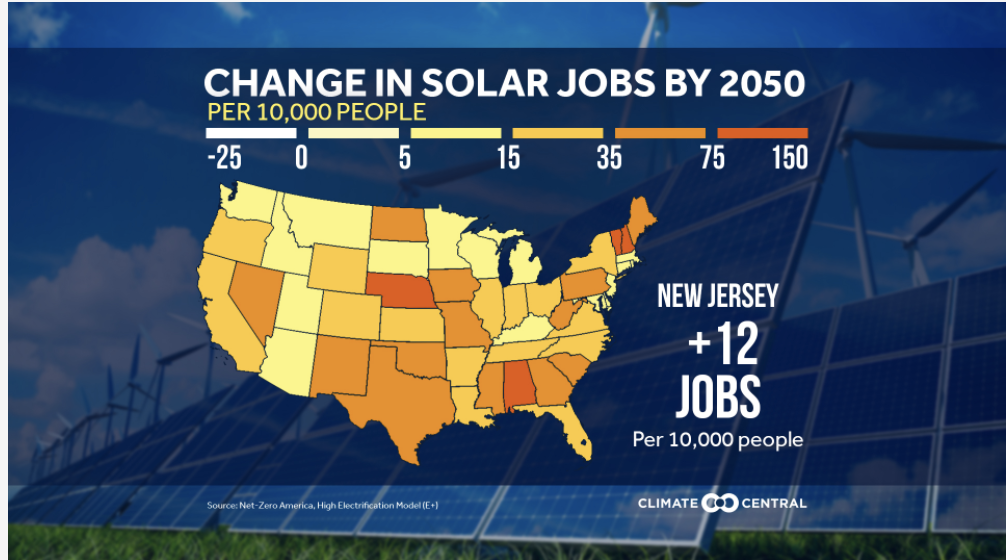MAR 10, 2021
A new Climate Central solutions brief on solar power examines one modeled pathway to net zero emissions that shows opportunities for significant job growth across the country. It also provides an overview of trends in solar in the U.S. and terminology.
KEY CONCEPTS
- Solar power has expanded dramatically in recent years, becoming the leading technology installed for new power generation around the world. In 2019, it accounted for 45% of global capacity added. Last year, solar power became the cheapest source of electricity in many parts of the world, outcompeting fossil fuels like coal and natural gas.
- A new Solutions Brief by Climate Central explains the growth of solar and dives into projections of how much more solar is needed to reach net zero emissions. Look for more Climate Central solutions issue briefs in the upcoming months.
- Despite the pandemic, the U.S. added a record 19 gigawatts of solar in 2020, for a total of 89 GW installed capacity. That’s enough to power 16.4 million American homes. But we have a long way to go.
- Net Zero America (NZA), a research initiative by scientists and engineers at Princeton University, identified five pathways by which the U.S. could transform its energy system to get to net-zero emissions by 2050. In one scenario, most states will see growth in utility-scale solar capacity (42 states) and in solar jobs (34 states) by 2030. By 2050, the economy could add 495 new solar jobs per 10,000 people nationwide, suggesting that solar could become a significant industry and major employer by the next decade.
Solar power has expanded dramatically in recent years, becoming the leading technology installed for new power generation globally. In 2019, it accounted for 45% of global capacity added. Last year, solar power became the cheapest source of electricity in many parts of the world, outcompeting fossil fuels like coal and natural gas.
Despite the pandemic, the U.S. added a record 19 gigawatts of solar in 2020, for a total of 89 GW installed capacity. That’s enough to power 16.4 million American homes. But we have a long way to go.
Net Zero America (NZA), a research initiative by scientists and engineers at Princeton University, identified five pathways which would get the U.S. to net-zero emissions by 2050. One scenario (high electrification, or E+) finds that most states will see growth in utility-scale solar capacity (42 states) and in solar jobs (34 states) by 2030. Overall, the economy could add 495 new solar jobs per 10,000 people nationwide, suggesting that solar could become a significant industry and major employer by the next decade. Some of the findings include:
- Texas and California, largely due to their size and sun exposure, lead the nation in the total number of solar industry jobs in 2030.
- Not unexpectedly, Florida, the Sunshine State, is expected to do well with the total number of solar jobs and solar job growth. Some of the largest solar installations in the country are breaking ground there in 2021.
- South Carolina is expected to lead in the ranking of total solar industry jobs per 10,000 people, and could have an additional 105 solar jobs per 10,000 residents by 2030.
- Nebraska and North Dakota, two states that are perhaps not thought of first for sunbathing, would see large increases in solar industry vocations.
- And solar jobs are not restricted to sunny states. By 2050, the model predicts over a half million solar manufacturing jobs nationwide, outpacing solar jobs in the construction sector.
Solar energy has a number of social and economic benefits. By displacing fossil fuel-based electricity, solar electricity generation can reduce not only carbon dioxide emissions but also reduce air pollutants that are a threat to public health. And if equitable policies to deploy solar energy are put into place, disadvantaged communities could see significant co-benefits such as reduced energy bills and good jobs (see examples in full brief).







